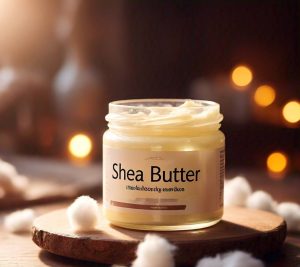Shea butter is a type of fat that’s extracted from the nuts of the shea tree, primarily found in Africa. It’s widely used in cosmetics for its moisturizing properties and it can also be used as a cooking oil.
The question at hand is whether you can microwave shea butter or not.
This article will delve into the specifics of microwaving shea butter, discussing whether this process affects its quality and nutrient content. If microwaving proves to be harmful, we’ll provide alternatives on how to melt or heat up your shea butter properly without causing any damage. We’ll also touch upon important facts about shea butter itself. The proper duration for microwaving it (if applicable), tips and precautions during handling are other topics that will be covered here alongside some frequently asked questions related to shea butter and a final word summarizing our key findings.

Jump To:
Can You Microwave Shea Butter?
Yes, you can microwave Shea butter. However, it should be done carefully to prevent overheating which can result in loss of its beneficial properties. Instead of using a high power level, use a low-medium setting to slowly melt the shea butter. Similarly, other substances like coconut oil can also be microwaved under similar conditions. Regardless of the substance being microwaved, always ensure safety and efficiency are prioritized.
Facts About Shea Butter
In this section, we will discuss the important things to note about shea butter.
- Origin: Shea butter is primarily cultivated in West Africa. It is extracted from the nuts of the shea tree (Vitellaria paradoxa).
- Nutrients: Shea butter contains several nutrients including Vitamins A and E, which help to boost skin health.
- Fatty Acid Composition: Comprises stearic acid (20%–50%), oleic acid (40%–60%), linoleic acid (<1%–10%) palmitic acid (~5%), linolenic acid(<1%) and arachidonic acids (<1%).
- Cosmetic Use: Due to its moisturizing properties, shea butter finds extensive use in cosmetics as a lotion or cream.
- Melting Point: The typical melting point for shea butter ranges between 32°C (89.6°F) – 45°C(113°F), making it solid at room temperature but easily melted with mild heat.
We have discussed the essential characteristics of shea butter above; now let’s focus on other aspects regarding microwaving shea butter.
Check out if you can heat sour cream in the microwave.
What are the Alternatives to Microwaving Shea Butter?
An alternative way of heating shea butter, rather than using a microwave, is by utilizing a double boiler. This method involves placing the shea butter in a small pot or dish and then setting that into a larger pot with some water in it. The heat from the boiling water will gently melt the shea butter. A similar approach uses hot tap water: pour it into a large bowl and place another smaller bowl containing shea butter inside, letting its warmth melt it down. Another technique includes just leaving your shea butter in room temperature or under sunlight until it softens naturally.
Check out if you can microwave guacamole.
Tips for Microwaving Shea Butter
Here are a few useful tips to microwave shea butter:
- You should always cut your shea butter into smaller pieces before microwaving as this will help it to melt evenly.
- Avoid overheating by setting your microwave power level at low or medium.
- Heat in short intervals; start with 15-20 seconds then stir and repeat if necessary.
- Always use a microwave-safe container when melting your shea butter to prevent any damage to both the product and appliance.
- If you notice that only part of your shea butter has melted after heating, simply stir till they all blend due to residual heat instead of further microwaving which might lead to overheating.
In conclusion, while direct microwaving isn’t recommended for melting shea butter due to potential nutrient loss and uneven heating, there are various methods available as an alternative.
In our next section, we’ll be discussing frequently asked questions pertaining to this topic.

Frequently Asked Questions (FAQs)
In this section, we will delve into the most commonly asked questions related to microwaving shea butter.
Can you microwave shea butter?
Yes, you can microwave shea butter. However, it should be done in short intervals and at a low power setting to prevent overheating. Overheated shea butter loses its beneficial properties; thus careful heating is crucial for maintaining its value.
At what temperature does shea butter melt in the microwave?
Shea Butter starts melting at around 90-100°F (32-37°C) when microwaved. It’s important to monitor the temperature as exceeding this range could compromise the quality of your shea butter.
How long should I microwave my jar of shea butter?
You’re recommended not to go beyond 10-15 seconds per interval while microwaving shea butter. Doing so helps control excessive heat build-up which can negatively impact your shea butter’s integrity.
Does microwaved shea butter retain its beneficial qualities?
Microwaved shea butter retains its beneficial properties as long as it isn’t overheated or burnt. Properly heated, it maintains its fatty acids and vitamins that are essential for skin health.
Check out if you can make gravy in the microwave.
If you have any more questions regarding heating or microwaving other substances like shea butter, feel free to contact us!
Final Word
Microwave-heating shea butter is an efficient way to liquefy it for various uses if administered correctly. The key lies in controlling the heat exposure to maintain all of its natural benefits and integral structure intact – just ensure not overheat! In conclusion, tread cautiously when handling sensitive elements such as these under heated conditions.



